#schist cap
Text
Front Yard Natural Stone Pavers
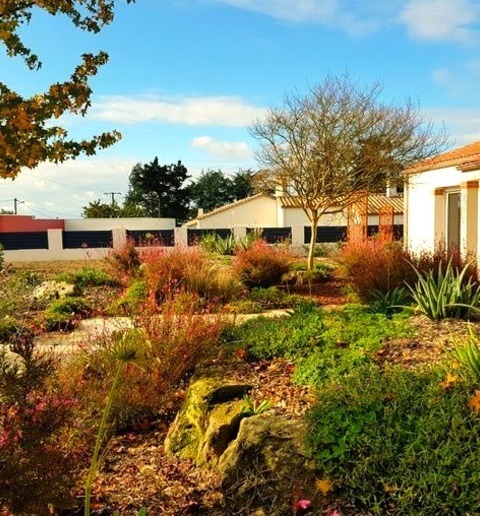
Here is an illustration of a sizable, modern stone garden path in the front yard that receives full sun.
#graminées#gauras lindheimeiri#rocher granit#marguerittes du cap#allée en dalles de schistes beige#paysagiste nantes#muret en pierres
0 notes
Text
Exploradoras Vol. II, part 1. Mapi & Ingrid weekend adventures, February 18-19, 2023. They went to Cadaqués, which is about 106 miles (170 km) north of Barcelona (2 hour drive). This is a Catalan town on a bay in the middle of the Cap de Creus peninsula, on the Costa Brava of the Mediterranean sea.
Mapi always looks so happy, especially whenever she is with Ingrid. Her smile kills me.

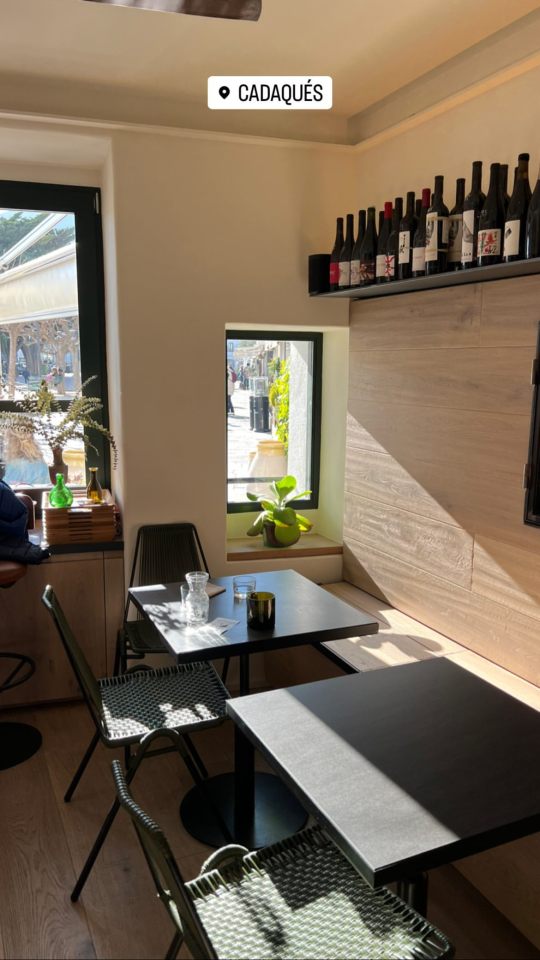



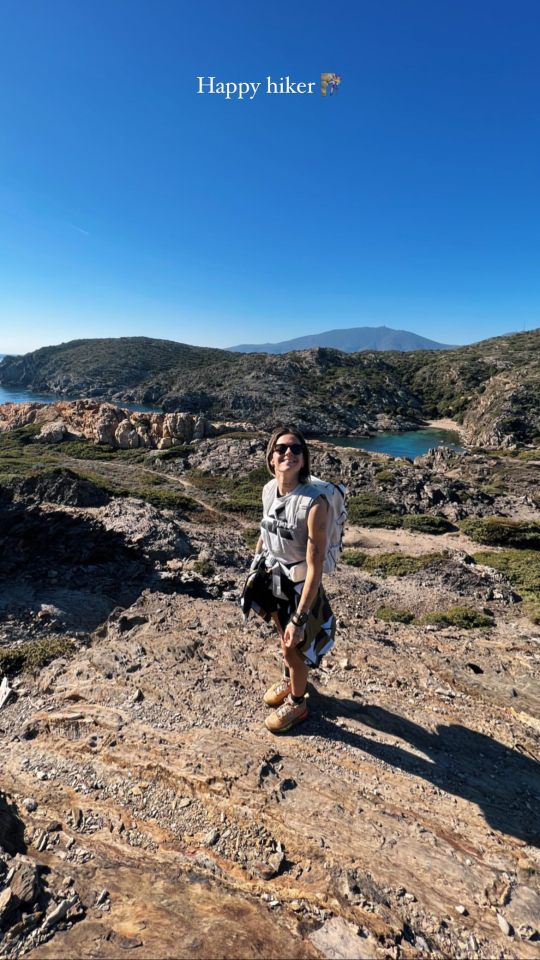
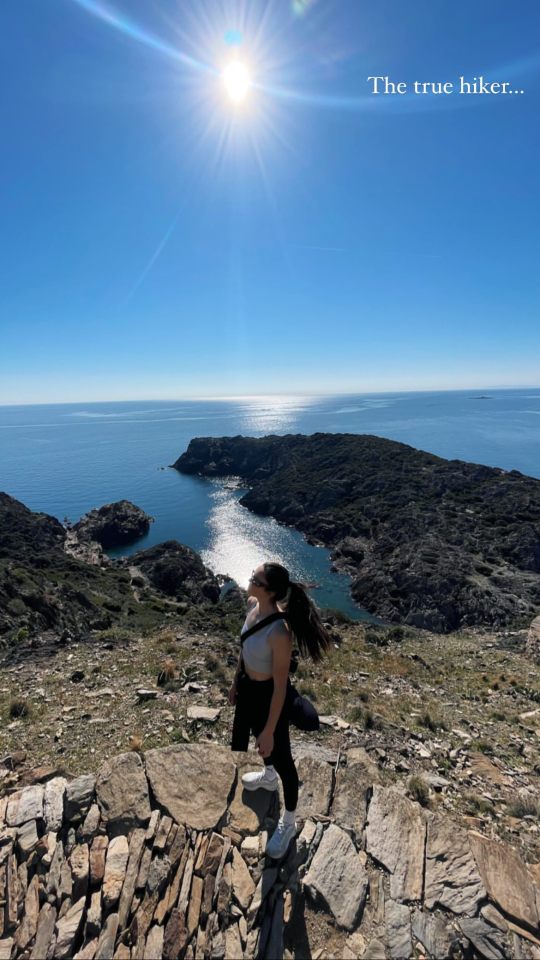


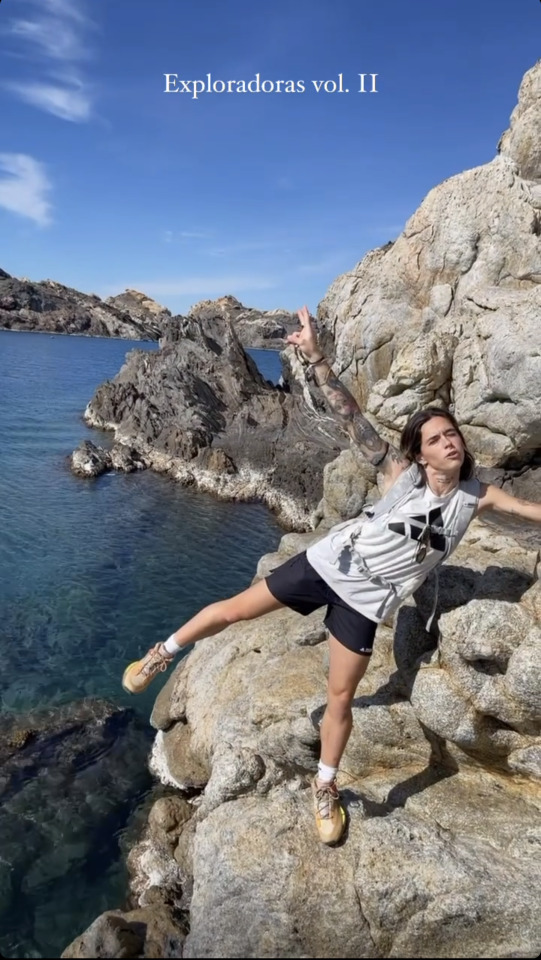
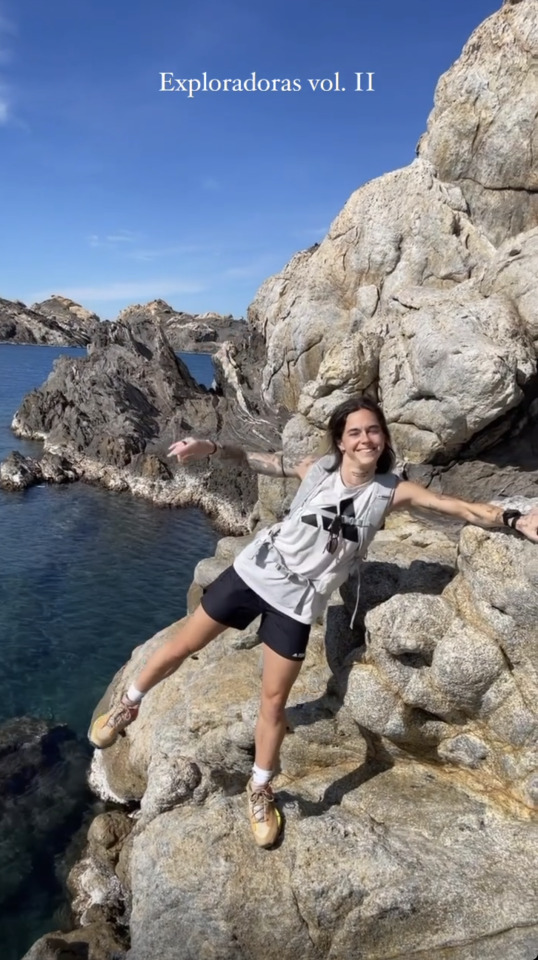
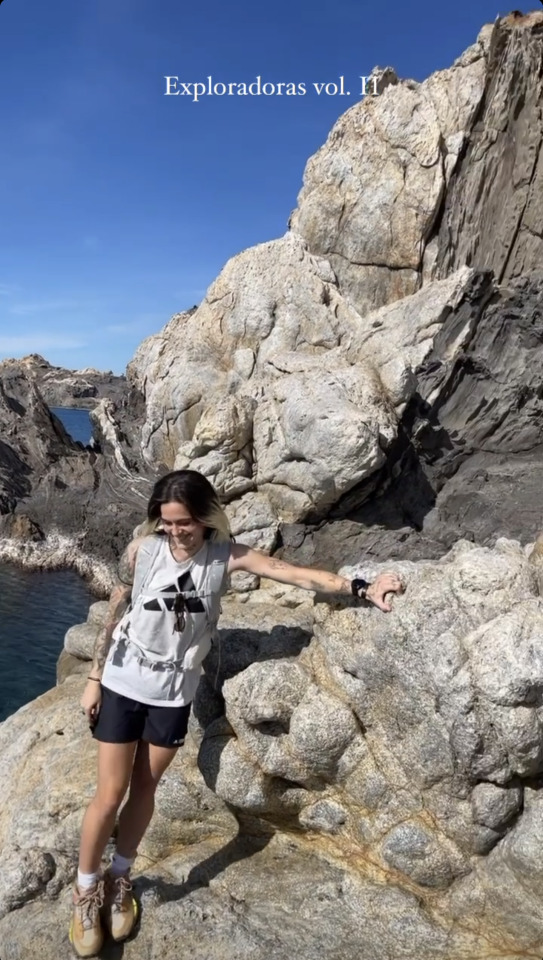

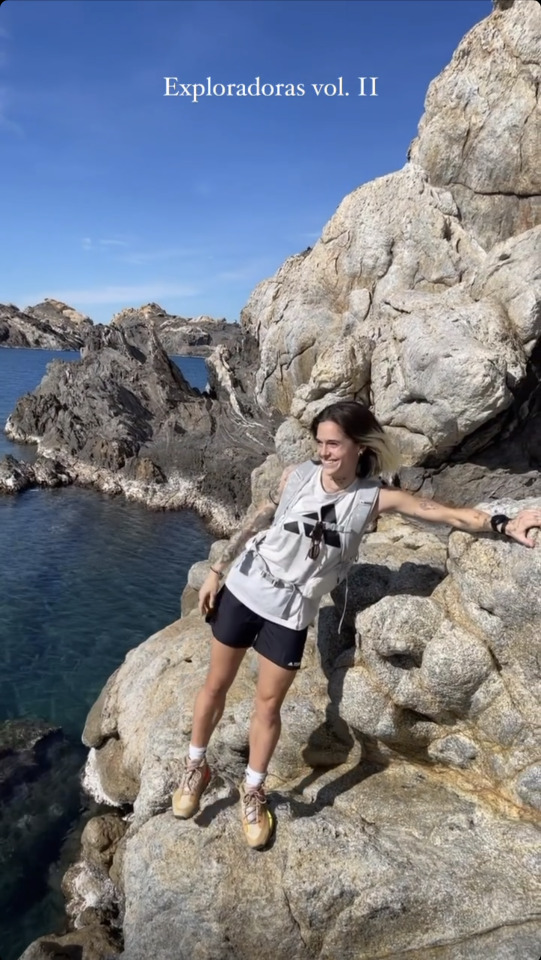


The geology here is unique. The rocks here were pushed up when the Pyrenees were formed, and are mostly metamorphic schists which turn a golden color in the Mediterranean sun. Add to that the weather: this is one of the wildest spots on the Costa Brava in the winter (Costa Brava means "wild coast"), so the migmatites and schists are battered and eroded by the Tramuntana wind which whips off the mountains and by a sea that appears as if it is boiling in the force 8 winds. The Cadaqués migmatites formed under extreme pressure and temperatures: a partial melt. They are halfway between an igneous and metamorphic rock. It also has the easternmost point in Spain / the Iberian peninsula.
There is strong art history in this area as well. Salvador Dalí lived here, as well as Pablo Picasso and several other artists.
#mapi leon#mapi león#maria leon#ingrid engen#mapi and ingrid#mapi smile#mapi goofy#mapi hiking#exploradoras#hiking#vacation#mapi vacation#food#mapi casual#off pitch#casual#fcb#fcb femení#fc barcelona femeni
25 notes
·
View notes
Text
Band That’s Too Cool To Really Exist of the Week:
The Travertine Terrors
A metal band that refuses to label themselves with that genre, and instead calls themselves “igneous rock.” Their songs are all about geology, and especially geological disasters and hazards, including:
“Dissolved In Acidic Hot Springs”
“Sulforous Stench of a Thousand Fumaroles”
“Entombed In Ash.” About pyroclastic flows.
“The Fall of Atlantis.” Power metal. A somewhat fantasticized account of the 1600 BCE eruption of Santorini.
“I Wanna Thrust Your Fault”. It’s... a song made almost entirely of terrible geology-based sexual innuendos and puns. Dozens and dozens of them. Possibly the first use of the word ‘Cummingtonite’ in song lyrics.
“The Year Without A Summer”
“Suffocating Limnic Eruption”
“VEI 8.” Usually the closing song of a concert, an extremely harsh and guttural 8-minute long track describing the collapse of society and humanity’s extinction after a catastrophic eruption of the Yellowstone Caldera.
Members include Micah Sparr (lead vocals), Andy Sikes (keyboard), Flint N. O’Doul (guitars), Weldon Tuff (guitars), Jack Schist (bass guitar), and Magnus ‘9.3′ Richter (drums). They all wear jeans and flannels or t-shirts on stage, with a mixture of cowboy hats and hiking caps, and all have enormous unkempt beards.
13 notes
·
View notes
Text
Les Murray
peneplain - a more or less level land surface produced by erosion over a long period, undisturbed by crustal movement
commissure - the joint between two bones; a band of nerve tissue connecting the hemispheres of the brain, the two sides of the spinal cord, etc
niveaux - plateaus
hyaline - a smooth sea or a clear sky; (chiefly of cartilage) glassy and translucent in appearance.
ruched
taupe - dark brownish grey (mole)
moraine - ridge of rock deposited along the edge of a glacier
pleasance - a secluded enclosure or part of a garden, especially one attached to a large house
vol (fr. flight)
surcingle - horse strap
nacre - mother of pearl
misericord
jacquard - a fabric has a design or motif woven into the construction of the weave
entail
philtre - love potion
chenille - soft fabric
shako - military cap
cullet
mucilage
paraison
marvered
spirochaetes
peruke - wig
jute
roan
distinguo - subtle distinction
decrepitation - the crackling or breaking up of certain crystals when they are heated
coralline - reddish, pinkish red
quoin - an external angle of a wall or building
coign - a projecting corner or angle of a wall
prehension - the act of taking hold, seizing, or grasping; mental understanding : comprehension
Oligocene
scads - a large number or quantity
gamboge - deep yellow
formic - relating to ants
rales - small clicking, bubbling, or rattling sounds in the lungs
escutcheon - shield or emblem bearing a coat of arms; flat piece of metal for protection and often ornamentation, around a keyhole, door handle, or light switch
pilum - Roman javelin
corniche - a road cut into the edge of a cliff, especially one running along a coast
bouillon - broth
impetigo - highly contagious skin infection that causes red sores on the face
goffer - crimp the lace edges of (a garment) with a heated implement
jardinière - decorative pot holder
terebinth - turpentine tree
chyle
sejant - animal upright in heraldry
cloison - dividing partition
mantling - piece of ornamental drapery depicted issuing from a helmet and surrounding a shield
marques - brand
lakatois - double-hulled sailing watercraft of Papua New Guinea.
ormolu - gilt bronze
azolla - aquatic fern
loden - dark green woolen cloth
donjon - medieval tower
pintle - a pin or bolt, usually inserted into a gudgeon, which is used as part of a pivot or hinge
antiphonary - a book of plainsong for the Divine Office
grimoire
oppidum - large fortified Iron Age settlement or town
tarmacadam - tarmac
cassia
caraway
schist
piste - a ski run of compacted snow
Gaeldom - Areas in which some Gaelic languages (Scottish Gaelic and Manx) are spoken
doughboy - United States soldiers during World War I
paseo (Sp.) - walk
coatee - a woman's or infant's short coat
VVS - “very very slightly included” diamond
illimitable - without limits or an end
Wilton rug - Axminster carpets are made by creating carpet tufts of equal length before attaching them to the backing. Wilton create pile in a continuous loop, and the cutting takes place once the pile has been attached to the backing
impatiens - flower genus
maidan - an open area or space in or near a town, often used as a marketplace or parade ground
sett - a hole in the ground, often with several passages and different entrances
fusee - flare?
finial - architectural elements typically used as decorative or ornamental features that mark the top or end of domes, spires, roofs, gables, buildings
perigee - the point in the orbit of the moon or a satellite at which it is nearest to the earth
pince-nez - style of glasses
shofar - Jewish horn
lorn - lonely
bowstave
bleb - blister
chiacking - the exchange of jeering or teasing remarks
arraign - call or bring (someone) before a court to answer a criminal charges
curcurbit - plant from gourd family
abyssal - of or relating to the bottom waters of the ocean depths; impossible to comprehend : unfathomable
tilth - tilled soil
sub rosa - in secret
antic - grotesque, bizarre
his nibs
talus - a slope formed especially by an accumulation of rock debris
Nunc Stans - Eternal existence as an attribute of God
oriel - a large upper-storey bay with a window
fistmele - is the breadth of a fist with thumb stuck out used especially in archery to give the correct height of a string from a braced bow
potch - opal which has no play of colour and is of no value
Borsalino - Italian hat
welter - confused mass, turmoil
infra dig
nose-gaffed
septum/septa
camelid
bitou - invasive bush
acrophobia - fear of heights
switchback - a road which goes up a steep hill in a series of sharp bends, or a sharp bend in a road
amethystine - scrub python
cotillon - 18th century dance
grue (Scot) - a shiver or shudder; a creeping of the flesh
cottar - in Scotland and Ireland a farm labourer or tenant occupying a cottage in return for labour
tufa - variety of limestone formed when carbonate minerals precipitate out of water in unheated rivers or lakes
fig - dress, appearance
bourdon - drone
fado - Portuguese music
paladin - trusted military leader; a leading champion of a cause
gelid - icy, extremely cold
natron - baking soda
baulk - roughly squared timber beam
clamant - urgently demanding attention
cupidity - greed for money or possessions
avocation - a hobby or minor occupation
unexceptionable - not open to objection, but not particularly new or exciting
drupe - a fleshy fruit with thin skin and a central stone containing the seed, e.g. a plum, cherry, almond, or olive
bund - retaining wall
Ishihara dots
rrark - Aboriginal cross-hatching
unkent - unknown, strange (Scot.)
jarl - a Norse or Danish chief
ebullition - a sudden outburst of emotion or violence
dunnage - a person's belongings, especially those brought on board ship
coggage
stetl - a small Jewish town or village formerly found in Eastern Europe
pukka
recension - a revised edition of a text
coeval - a person of roughly the same age as oneself; a contemporary
peculator - embezzler
pasquil - a satire or lampoon
asthenic (asthenia) - abnormal physical weakness or lack of energy
canaille - common people; the masses
monorchidism - (or monorchism) the state of having only one testicle within the scrotum
sera - an amber-coloured, protein-rich liquid which separates out when blood coagulates
ichor - fluid that flows like blood in the veins of the gods; watery discharge from a wound
bordure - In heraldry, a band of contrasting tincture forming a border around the edge of a shield
boi meat - ox meat (Galician)
in-continuo
chivvy - tell (someone) repeatedly to do something
biltong - dried meat
wobbegong - carpet shark
bijou - small dainty usually ornamental piece of delicate workmanship : jewel; something delicate, elegant, or highly prized
placket - a finished opening in the upper part of trousers or skirts, or at the neck, front, or sleeve of a garment
tumbril - two wheeled cart
grab-bar
gomp
beetle bix
dottle - unburned and partially burned tobacco in the bowl of a pipe
mezedes or meze - small plates of appetisers (Greek)
whale sounding - diving
bootless - ineffectual, useless
galligaskins - loose wide hose or breeches worn in the 16th and 17th centuries
Ricardian - people who dispute the negative posthumous reputation of King Richard III of England
precarian (precariat) - a social class formed by people suffering from precarity, which means existing without predictability or security, affecting material or psychological welfare. The term is a portmanteau merging precarious with proletariat
besoming - sweeping (besom - a broom made of twigs tied round a stick)
gilet - a waist- or hip-length garment, usually sleeveless, fastening up the front; sometimes made from a quilted fabric, and designed to be worn over a blouse, shirt, etc; bodice resembling a waistcoat in a woman's dress
swart - swarthy, dark
voile - sheer fabric
1 note
·
View note
Text
Sankari Uttarakhand- A Complex Geological Trekking Destination
Sankari Uttarakhand
Sankari Mountain Peak is located in the Garhwal Himalayas of Uttarakhand, India. It is part of the Bandarpunch mountain range and has an elevation of 6,398 meters. Sankari Mountain is considered a challenging peak for mountaineers and a Complex Geological field. It is located in the Govind Wildlife Sanctuary and National Park, which is known for its diverse flora and fauna, including musk deer, snow leopards, and Himalayan black bears. The Sankari Mountain region is also a popular trekking destination for adventure enthusiasts. The trek to the summit of the peak involves traversing through high-altitude meadows, crossing streams, and navigating steep ascents and descents. The trek also provides stunning views of the surrounding peaks and valleys of the Garhwal Himalayas.
Sankari Uttarakhand Geology
Sankari is a part of the Greater Himalayan Range. The geology of this region is dominated by the presence of several geological structures, including the Main Central Thrust (MCT), the South Tibetan Detachment System (STDS), and the Main Boundary Thrust (MBT). The area around Sankari is primarily composed of sedimentary and metamorphic rocks, which were formed due to the collision between the Indian Plate and the Eurasian Plate. The sedimentary rocks include shale, sandstone, and limestone, while the metamorphic rocks include gneiss and schist. The Main Central Thrust (MCT) is an important geological structure in this region, which separates the Higher Himalayan Crystalline rocks from the Lesser Himalayan Sedimentary Sequence.
The South Tibetan Detachment System (STDS) is another important geological structure in the region, which separates the Indian Plate from the Tibetan Plateau. The Main Boundary Thrust (MBT) is a major geological structure in the region, which separates the Lesser Himalayan Sedimentary Sequence from the Siwalik Group. The MBT zone is characterized by intense thrusting and folding, which has led to the formation of several ridges and valleys in the region.
Sankari Uttarakhand weather
The weather in Sankari, Uttarakhand can vary depending on the time of year. Sankari is located in the Garhwal Himalayas at an altitude of over 2,000 meters, so it experiences a cool and pleasant climate throughout the year. Summer months (April to June) are the best time to visit Sankari, as the weather is mild and the skies are clear. The daytime temperatures during this time range from 15 to 25 degrees Celsius, while the nighttime temperatures can drop to 5 to 10 degrees Celsius. The winter months (December to February) in Sankari are cold, with temperatures ranging from 0 to 10 degrees Celsius. during the day, and dropping to sub-zero temperatures at night. The region receives snowfall during this time, making it a popular destination for winter sports enthusiasts.
Also read- Joshimath Uttarakhand-A Sacred Place in Nanda devi valley
Har Ki Dun valley
Har Ki Dun is a scenic valley located in the Uttarkashi district, at an elevation of approximately 3,566 meters above sea level. The valley is situated in the western Garhwal Himalayas and is surrounded by towering peaks, including Swargarohini and Bandarpunch. The valley is also home to the Har Ki Dun river, which originates from the Jaundhar glacier and flows through the valley. Har Ki Dun valley is known for its natural beauty, with lush green meadows, dense forests, and snow-capped peaks. The valley is also home to several high-altitude villages, including Osla, Taluka, and Gangad.
The valley is a popular trekking destination and attracts thousands of trekkers and nature enthusiasts every year. The trek to Har Ki Dun is a moderate trek, which takes around 6-7 days to complete. The trek passes through several scenic locations, including Sankri, Taluka, Osla, and Kalkatiyadhar. Along the way, trekkers can also witness several waterfalls, glaciers, and alpine lakes.
Kedarkantha
Kedarkantha is a mountain peak located in the Uttarkashi district at an elevation of approximately 3,810 meters above sea level. The peak is situated in the Govind Wildlife Sanctuary and is surrounded by several other mountain peaks, including Swargarohini, Bandarpunch, and Black Peak. Kedarkantha is a popular trekking destination and attracts thousands of trekkers and nature enthusiasts every year. The trek to Kedarkantha is a moderate trek, which takes around 4-5 days to complete. The trek passes through several scenic locations, including Sankri, Juda Ka Talab, and Kedarkantha base camp. Along the way, trekkers can witness several waterfalls, streams, and dense forests of pine and oak trees.
Things to do around Sankri
Sankri is a popular destination in Uttarakhand, India, located in the Garhwal Himalayas. It is known for its scenic beauty, trekking routes, and cultural heritage. The best thing to do around Sankri is Trekking. It is the base camp for many treks in the region, including the Kedarkantha trek, Har Ki Dun trek, and the Bali Pass trek. These treks offer stunning views of the surrounding peaks and valleys of the Garhwal Himalayas. Sankri is a beautiful and peaceful village located amidst the mountains. It is known for its traditional architecture, temples, and friendly locals.
The Govind Wildlife Sanctuary is located near Sankri and is home to a variety of flora and fauna, including musk deer, Himalayan black bears, and snow leopards. The Juda Ka Talab is a scenic lake is located about 5 kilometers from Sankri and is a popular spot for picnics and photography. Sankri is known for its colorful and vibrant festivals, including the Phool Dei festival, which celebrates the arrival of spring, and the Bikhauti Mela, which is held to honor the goddess Ganga. Himalayan Trout House is an eco-friendly farm located in Sankri and offers visitors the opportunity to learn about sustainable farming practices and try local cuisine. Sankri is surrounded by beautiful natural scenery, including snow-capped peaks, alpine meadows, and rivers. It's a perfect destination for nature lovers and photographers.
Delhi to Sankari Uttarakhand
Sankari is located in the Uttarkashi district of Uttarakhand, India, and is approximately 442 kilometers from Delhi. The nearest airport to Sankari is the Jolly Grant Airport in Dehradun, which is around 208 kilometers away. You can take a flight from Delhi to Dehradun and then hire a taxi or take a bus to reach Sankari. The nearest railway station to Sankari is the Dehradun railway station, which is around 195 kilometers away.
0 notes
Photo
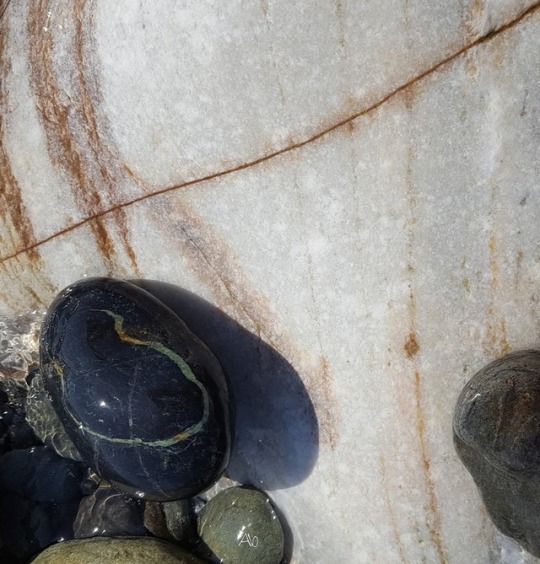

Joyaux imaginaires pour un non-anniversaire.
#galets#coquillage#schistes lustrés#ciplolins polis#pebbles#gemstones#imaginery#jewels#mineral#photod'aliceblue#Cap Corse#isula#mediterranean#island#shell
16 notes
·
View notes
Note
please infodump 2 me, we've been having it rough lately and you sharing an interest might make our day :)
okay, so I was recently on vacation in the Appalachian mountains and I’ve kinda been thinking a lot about this
I visited Mt. Mitchell, which is the highest point in North America east of the Mississippi River, at an elevation of 6,684 feet.
(Here’s the view from the top.)

This is high enough that this area of the Blue Ridge Mountains has a unique kind of ecosystem similar to that found in eastern Canada, of fir, cedar, and spruce trees and many more cold-adapted species.

I love the Appalachians. The blue, undulating waves of mountains seem to melt straight into the sky in the distance. But they are not impressive in terms of height, not really. To someone used to the Rockies, Mt. Mitchell is more of a glorified hill than anything.
Where I live in Eastern Kentucky, the line between mountain and glorified hill blurs. The Appalachians shade from waves of mountains to steep rolling hills with scarcely a transition. They aren’t impressive, staggering peaks. You might even call them unremarkable.
You would be wrong.
The Appalachians are not high, but they are old. They are much, much older than the lofty snow-capped peaks of their more impressive relatives. They are so small because they have been worn down, for hundreds of millions of years, from a height that rivaled that of the Himalayas. In their youth, these soft, subtle curves on the misty horizon were Everests.
The Appalachians were created by a long string of geologic events, culminating in the collision of the African continent with the Eastern coast of what we now know as North America, 300 million years ago. And yes, in those days, that WAS the coast.

Where did all that land come from??
Well, remember what I said about millions of years of erosion? All the land east of this mountainous region…is made essentially from sediment worn off the Appalachian’s eons-old peaks. The entire East Coast is just leftover rubble, carried by erosion, from what was the Appalachian Mountains.
What is left…is old.
Much of Kentucky is sedimentary limestone, forming some of the best fossil beds in the world. The central area of the state was a shallow sea 450 million years ago, and well-preserved sponges, corals, bivalves, gastropods, bryozoans, crinoids, and even trilobites can be found here.
The reason there are no fish is that fish were not invented yet.
In order: Gastropod (snail) shell, a bryozoan (or ‘moss animal’ fragment, more bryozoans, another snail shell, and a shit ton of Strophomena bivalves.





I found all these just…in my back yard.
These are older than our pal Tyrannosaurus Rex, and by older I mean 6.5 times older, as in “the amount of time that separates humans from T. rex passed almost seven times from the time these little guys fossilized to now.”
Which makes it pretty terrifying that the rocks of the Appalachian mountains are much older than that.
At the center of the map above you’ll see the Blue Ridge mountains. This region, at the mountains’ heart, was first uplifted over one billion years ago.
When the Blue Ridge was young, multicellularity was an experiment. Seven hundred million years would pass before fish would try to crawl onto land. Go back to the time of the first dinosaur, when mammals hadn’t been dreamt of, then do that three more times, and that’s how old these mountains are.
Western North Carolina is known for its minerals, especially mica. There’s even a Micaville, North Carolina, and a Kona, named after the chemical composition of potassium feldspar. (Not recommended to visit. We got shot at. 0/10.) The stones there that contain this mineral are schist, a high-grade metamorphic rock, formed under the utmost heat and pressure. Today, they are exposed to the surface, billion-year-old secrets finally relinquished by these old mountains.
The Appalachians may be sanded down by time, but they remember when they towered over a world where life was a little slimy experiment. The dinosaurs rose and fell and they barely noticed. Humans plunder their mineral riches, dreaming of wealth and industry, but those things have no meaning on the geologic timescale.
From the peak of Mt. Mitchell, a large orange wound in the earth can be seen, a feldspar mine. Plaques and exhibits in the museum tell of how we cut down the trees and carved out the minerals, of our power to damage a fragile and ancient landscape.
It should matter to us. The world is our habitat, and we will have to live with the loss of what we destroy. But to the mountains?
Mass extinctions are followed by explosions of life. New organisms evolve to fill the niches left by those that disappear. It is a cycle that repeats again and again, a comforting rhythm.
Horror set in this environment often focuses on the perceived wrong humans do to their environment, plundering them, stripping them of resources. As if the horror of future climate disaster is retaliation, and not simply what we’ve wrought. The Appalachian Mountains are exploited by the greedy, but they don’t punish us. I don’t think they do. They’ve seen all this before, after all.
What can we take from them that matters, when they, as they finally wear down to smooth and rolling hills, will bury us as they have all the others, and not even stir from their sleep?
#writing#geology#appalachian mountains#fossils#appalachia#my writing#cursed geology#science#life history
2K notes
·
View notes
Photo

Head of a Kushite Ruler, ca. 716-702 B.C.E., Brooklyn Museum: Egyptian, Classical, Ancient Near Eastern Art
Head of a king in unidentified green stone, originally furnished with back pillar. Full, almost square face with eyes and brows originally inlaid, bull neck. Skin areas polished scalp area dull and covered with close fitting ‘cap’ with small, rounded flaps near ears; uraeus with wide curve. Condition: Inlays lost, right eyelid chipped. Ears slightly chipped. Headdress apparently has been hammered though possibly it was covered with metal fitting in antiquity.
Size: 2 3/4 x 2 1/16 x 2 9/16 in. (7 x 5.3 x 6.5 cm)
Medium: Green schist
https://www.brooklynmuseum.org/opencollection/objects/3685
4 notes
·
View notes
Photo

The Ruwenzori
Here are veiled wonders: East Africa’s Ruwenzori, also called the Mountains of the Moon. They hide their summit splendours behind an almost permanent mantle of cloud and it is only when veering winds tear back the curtain of mist that their snow-capped grandeur is revealed.
The explorer Henry Morton Stanley reached the mountain range, previously unrecorded by Europeans, in 1888. He noted that for 300 days of the year the peaks were concealed by brooding cloud, but when it parted the views were stupendous.
Ruwenzori means ‘rainmaker,’ and it was Stanley who applied the Bantu name to these glistening snow mountains that are less than 30 miles (48km) from the equator. Their craggy mass sprawls for some 60 miles (96km) along the border of Uganda and Democratic Republic of Congo. Towering mountains, with glaciers creeping down their valleys, rake the sky at the heart of the massif.
The Italian Duke of the Abruzzi, Luigi di Savoia, first scaled, mapped and photographed the mountains in 1906. But a dim awareness of their existence has much more ancient pedigree. More than 2000 years ago, Greek geographers had spoken of mysterious mountains whose snows and torrents fed the headwaters of the Nile. Aristotle referred to a ‘silver mountain’ in central Africa in the 4th century BC, and Ptolemy called them the ‘Mountains of the Moon.’ Ptolemy’s mountains are now thought to be the Ruwenzori.
Rock that sparkles
When the mists clear, the peaks seem to glow with an eerie brightness that has to do with more than the snow. The rock itself sparkles, for the underlying granite is topped by mica schists—glittering, course-grained rocks transformed by the heat and pressure of mighty earth movements.
The Ruwenzori were not shaped, as were Kilimanjaro and Mount Kenya, by volcanic action. Instead, an immense block of land was lofted heavenward and tilted in a drama that took place less than 10 million years ago. This comparative youthfulness contributes to the jagged vigour of the mountains’ profile.
Probably the most wondrous sight in the Ruwenzori is the weird vegetation which creates an eerie and improbable landscape on the mountain’s slope.
~ JM
Image Credit: https://commons.wikimedia.org/wiki/File:Ruwenzori_Mountains_Virunga_National_Park.jpg
More Info:
Rwenzori Mountains National Park: http://bit.ly/1zBcOgN
Peter, M. (2009). The Ruwenzori (Rwenzori) Mountains, Africa.
https://editors.eol.org/eoearth/wiki/The_Ruwenzori_(Rwenzori)_Mountains,_Africa
Williams, Richard S., Jr. (editor) (1991) Glaciers of the Middle East and Africa, In U. S. Geological Survey Professional Paper, 1991, pp.G1-G70.
99 notes
·
View notes
Text
The most romantic non-date
June 25 2019, retrospective
There’s a lot of things I want to remember about my day with Sèbastien. He was older than I expected, it turned out he was 46. And he was in incredible shape, much better than me, the kind of toned body from a person who actually uses their body every day, not at the gym but just through living life. He was so, so tan. Everybody was in the south. By the time I left, I was almost one of them. The hat was funny, it was one of those flat brimmed DC caps that gave him such a youthful touch and would be cliché or look dirt baggy on a younger guy. I remember thinking that his face seemed super French with his bone structure and mouth especially, but now I can’t even paint a mental picture of him. I remember a little greyness but I can’t remember if it was in his hair or whether I might have noticed it in a beard, or whether he even had one. I regret not looking at his hands.
As he puttered around on the boat, getting us where we needed to go, he would sing and hum softly to himself. It absolutely caught me by surprise, almost every time. I still forget that he did that and then I remember all over again and think it’s a wonderful trait for a person to have. The one thing he did that I didn’t like was pull a starfish out of the water to show me... “she” was beautiful but I felt so uncomfortable knowing she was wrenched from her perch, and I just wanted him to put her back. In that moment though, there was a youthful and boyish fascination. He wanted me to see her little suction cups, and explain that her short legs were probably the result of an attack by birds. I like the enthusiasm, even though I already know or guessed most of these things.
Our first stop was the beach of Port Cros, where there’s a small dock to tie up. As he secured the boat he would murmur in French, English, or a combination. Several times I heard the word, “Alors,” not knowing what it meant. I asked, but he was confused, he didn’t know what word I was asking about. Then again he said it. “Aha!” I pointed at his face (bad manners). “There it is again!” “Which?” “The last one. Alore?” “Ahhh, Alors.” “Yeah that, what’s it mean?” Bafflement in attempting to explain. “Is it like how we use “okay” in English? It kind of fills lots of gaps?” Yes, kind of.
From there we snorkeled and eventually went ashore because the waters were still pretty cold except for in the shallows. On shore we went without shoes, and he checked with me twice to make sure that I was sure I was comfortable (I was). I said I prefer living life barefoot, which is obviously not possible in the city. He said he kicks off his shoes in March and doesn’t put them back on until September, but that a few weeks ago he’d been touring with a German couple who insisted they didn’t need shoes, only to have to cut the hike short because of their sensitive feet. He took me to the top of a lookout point by an abandoned building that I think had a green door. Made a joke about it being a nice little house if you could fix it up. On the way back down I stopped on the trail to take a deep breath and he turned around, mistaking my inhale for a gasp. I was just taking in the piney, jasmine, mineral and dusty scent of the island that smelled so much like summer. On the walk back to the dock we stopped to people watch a minute at the beach, and for some reason on the dock I wound up explaining that next year I would be returning to go to Bordeaux for my sister’s wedding (”No, she’s not French, it’s just that you have a destination wedding when you want to be polite and invite people but you don’t want them to accept or actually come.” “That seems like a good solution.”) Had a small snack on the boat. I don’t remember in what order or when we got to talking, but the similarities were so striking - at least to me:
- On Mexican cenotes, both having been. His experience was to stop and listen. “What did you hear?” “My heart.” There was a thoughtfulness and a pause, there seemed to be more that couldn’t be expressed in English.
- On liveaboarding, both having done. He crossed the Atlantic in 11 days, 5 days of prep, on a catamaran with 3 or 4 friends, going from Africa to Brazil. God if that isn’t just the sexiest thing ever. I wonder if that was before the kids.
- On camping. Every year at the peak of tourist season in August he “disappears into the mountains” for a week. He mentions the calanques to me, and asserts that I know them, which I think is funny or flattering maybe that he assumes I know.
- On environmentalism. He tries to avoid plastic and brings his reusable bags to the weekly market, stepping into a grocery store only once or twice a month. Trying to teach environmentalism to his 3 kids.
- On adventure. “Would you ever live on a boat and sail around the Mediterranean?” Absolutely. But there’s the kids to consider (2 teens, 1 around 9) and the several small businesses. (He seems to be a “guy I know” kind of guy). But someday.
Maybe that’s when he asked my age, which surprised me mildly. I think that was when he mentioned I was young enough still to have those adventures. I regret noting out loud how he had his first kid when he was my age, because it put a space between us that I don’t think needed to be there.
There’s a word he used, a great one. I can’t remember what it was but it floored me that a non-native speaker knew it. I told him this, that I know many English speakers who don’t even know that word. He either didn't understand or didn’t have a response. I wish I could remember the word.
It’s funny to me that he thinks Italy’s food is better than France’s, on account of it being simple ingredients of the highest quality. That’s what I thought France did so well. His expression towards the ocean seems wistful, longing for the larger and wilder waves.
I tell him about Arizona when he mentions the vast wildernesses of America being so alluring. I could live there if it weren’t so far from the sea, and he seems to nod agreement.
I have a rant about rich people, their yachts, and the weird and annoying things they do with their money. I think he’s probably just humoring me or being polite and I mention that my friends tell me I talk about depressing things, which makes him laugh. I grimace and apologize.
At a little cove where we stop again to snorkel, I wander ashore to look at the schist folds more closely and then I notice plastic, and the more I look the more of it I see. I already found a plastic bag and tucked it into my bikini side, to dispose of after swimming. I start collecting bits of plastic, rubber wine corks, and mostly styrofoam. When I turn around, Sèbastien had paddle boarded over and produced a half torn garbage bag from the ground and was filling it, so we worked silently, picking up pieces until the bag was full. I noticed moments before he said aloud that the more pieces we picked the smaller the remaining ones got. I made a comment about micro plastics. It was depressing, realizing in a moment of pause that there was still so much rubbish around. That’s when he unwittingly gifted me the mantra I didn’t know I needed:
“Alors. It’s not everything, but it’s important.” It washes over me like cold water, jarring and refreshing all at once. I never believed in love at first sight until this day.
There’s a seagull back by the boat that’s cautiously optimistic about our picnic lunch. Sèbastien tries to lure it with various treats (it doesn’t care for watermelon). Is it true that we both think these common birds are beautiful, or is he just being agreeable so I have a good tour experience?
After about 5 hours in the sun I’m getting drowsy and the boat motion is lulling me to sleep as I nod off while he’s driving, and he offers me a towel for my head. I get the impression that this is someone used to caring for other people, and realize that’s what I need.
I need to be able to relax, but to relax I need to trust that somebody else has their hands on the wheel. And I could cry with relief at this realization and with frustration that the person who gave it to me is probably completely unattainable.
Coming into the final harbor we talk about the Levant and he admits he never spends any time there but he isn’t sure why, other than that the kids are emphatic about not wanting to go. I laugh because of course that makes perfect sense.
I want to see him again. The kids are going to NYC next week with their mother, but he’s never been. I say I have an AirBnB and he’s welcome to stay if he ever decides to go, and that I hope he does. It’s 5pm and it feels abrupt when he says he should leave. I’m left wondering if I came on too strong or made him uncomfortable with the overture of invitation. Then I wonder too if maybe I didn’t come on strongly enough.
It’s a cruel coincidence that the house I stay at in Hyères is steps away from the one he rents out to vacationers. It’s even crueler that the day after our day I see the same yellow boat on the dock and have to convince myself it’s not his. I could have talked to him for many, many more hours than we had. I so want to see him again and have no idea if this is me being limerent again or whether there was some mutual connection.
When’s the last time I had so much in common with a person? It feels like never. But maybe I am living in the wrong places, maybe for him it’s common and the people around here are often outdoorsy, adventurous environmentalists. This might be the (possibly misleading) lynchpin that convinces me to make the move.
3 days later I ask if he has a website for the environmentalist friend who runs the NGO and a week after that there’s still no response. I don’t have any recourse except to chalk it up to one-sided attraction, which makes me deeply sad and I’m not ready to let it go yet.
1 note
·
View note
Text
The PokeSpe Dexholders Group Chat
The chat was created by Green (m) for important information and as a way to contact each other in an emergency.
Nobody cared so now it’s been taken over by memes.
The chat’s name gets changed like once every few weeks, but it’s currently Are You A Boy Or A Girl?
Green muted his notifications and every time he goes on to announce a reunion or whatever he finds some weird schist that scars him for life.
He also always changes the name back to Pokedex Holders but then it gets changed to something like Green Sucks as soon as he leaves.
The profile picture is always a picture of a cute Pokemon.
Red’s screen name is Ketchup.
He’s the ultimate meme spammer.
Blue (f)’s name is I think ______ is hawt and she puts random dexholders there when she feels like it.
Everyone’s decided that whenever she changes it that person has to send a minute long video of them stammering and blushing.
Most of the dexholders do an exaggerated, dramatic thing, but Yellow’s seemed really, REALLY genuine so now they all ship it.
Yellow’s name is UwU.
She spams UwU and heart-eyed emojis.
Gold’s name was ( ͡° ͜ʖ ͡°)
He got banned ages ago.
You don’t want to know why.
No, you really don’t.
Silver likes his screen name to be his actual name.
But Blue constantly hacks into his phone and changes his name.
Edgy McEdgeLord, Nico Di Angelo, I Totally Don’t Have A Crush On Gold and The Killjoy Who Killed All The Joy were some of them.
Silver keeps saying that he’s going to leave the chat and never come back, but he never does.
Crystal’s names are all hopeless attempts to be trendy.
One time she named herself Tide Pod and nobody ever let it go.
She was the only one that Green trusted with Admin status.
Ruby’s name are sparkly emojis.
He sends selfies with filters and pictures of his food.
Sapphire just hits the keyboard in all caps randomly.
Her screen name is AFHUINFXKHUFADJFDKJBNFAFGBFHSJN.
Emerald’s name is I Hate Everyone On This Chat.
And he does.
So he just has notifications off and pretends it doesn’t exist.
Sometimes he sends a Star Wars meme or something.
Diamond is Speaking.
Pearl is Of.
And Platinum is Pokemon.
Diamond and Pearl send videos.
Platinum doesn’t understand the internet so autocorrect does the weirdest things to her messages.
She also forwards fake news in a panic.
The younger dexholders are all on the chat too but don’t say much because they’re too busy almost dying.
But Sun always finds time to spam ‘NYAAAAAAAAAAAAAAAAAAAAA!!!!!’
The chat is just kind of a mess.
Yay.
#PokeSpe#Headcanon#Headcanons#Pokemon#Pokemon Special#Pokemon Manga#Pokemon Adventures#PokeSpe Headcanons#Group Chat#PokeSupe
31 notes
·
View notes
Text

Belvedere Castle Central Park NYC New York City USA
#BelvedereCastle #CentralParkNYC #USA
Belvedere Castle is a folly in Central Park in Manhattan, New York City. It contains exhibit rooms and an observation deck, and since 1919, has housed Central Park’s official weather station.
Belvedere Castle was designed by Frederick Law Olmsted and Calvert Vaux in 1867–1869. An architectural hybrid of Gothic and Romanesque styles, Vaux's design called for a Manhattan schist and granite structure with a corner tower with conical cap, with the existing lookout over parapet walls between them. Its name comes from belvedere, which means "beautiful view" in Italian.
Belvedere Castle was built as a shell with doors and windows open to the weather. Originally, the main tower had a more medieval design, with a weather antenna on top, but during the castle's 1983 renovation, the tower was restored in a German style with a flag, a weather vane, and an anemometer on top. The two fanciful half-timbered wooden pavilions deteriorated without painting and upkeep and were removed before 1900, but restored in the 1980s.
Starting in 1919, Belvedere Castle housed the New York Meteorological Observatory, which had been taken over by the United States Weather Bureau. The current weather station in Central Park, an Automated Surface Observing System (ASOS), is located immediately south of the castle, though wind equipment is still located on the main tower.
A castle is a type of fortified structure built during the Middle Ages predominantly by the nobility or royalty and by military orders. Scholars debate the scope of the word castle, but usually consider it to be the private fortified residence of a lord or noble.
********************************
Apple iPhone 12 Pro Max smartphone photo
**********************
New York City - USA - November 27th 2021
#Belvedere #Castle #BelvedereCastle #Castles #CentralPark #CentralParkNYC #NY #NewYork #NYC #NewYorkCity #NYNY #NewYorkNewYork #NewYorkState #Manhattan island borough #🍎 # 🌃 zip code 10024 #USA #🇺🇸 country North America continent #Autumn season 🍁 #beard #beards #ManWithBeard #BeardedMan #Bearded #Face #FacialHair #mustache #iPhonePhoto #iPhonePhotography #RyanReporting @ryanjanekwolowski @nytimes @iloveny @ILoveNewYork @I❤️NY
0 notes
Text
UChicago institute helps reassemble ancient, rare art from first to 6th centuries
BAMIYAN, Afghanistan — Here is a reminder to someone with the initials A.B., who on March 8 climbed inside the cliff out of which Bamiyan’s two giant Buddhas were carved 1,500 years ago.
In a domed chamber — reached after a trek through a passageway that worms its way up the inside of the cliff face — A.B. inscribed initials and the date, as hundreds of others had in many scripts, then added a little heart.
It’s just one of the latest contributions to the destruction of the World Heritage Site of Bamiyan’s famous Buddhas.
The worst was the Taliban’s effort in March 2001, when the group blasted away at the wooden buddha statue, one 181 feet and the other 125 feet tall, which at the time were thought to be the two biggest standing Buddhas on the planet.
It took the Taliban weeks, using artillery and explosive charges, to reduce the Buddhas to thousands of fragments piled in heaps at the foot of the cliffs, outraging the world.
Since then, the degradation has continued, as Afghanistan and the international community have spent 18 years debating what to do to protect or restore the site, with still no final decision and often only one guard on duty.
One recent idea came from a wealthy Chinese couple, Janson Hu and Liyan Yu. They financed the creation of a Statue of Liberty-size 3D light projection of an artist’s view of what the larger Buddha, known as Solsol to locals, might have looked like in his prime.
The image was beamed into the niche one night in 2015; later the couple donated their $120,000 projector to the culture ministry.
Editors’ Picks
‘Very Ordinary’ Astronauts Prepare for an Extraordinary Launch to Space
Why Use a Dictionary in the Age of Internet Search?
The Rock That Ended the Dinosaurs Was Much More Than a Dino Killer
Continue reading the main story
The local authorities bring it out on special occasions, but rarely, as Bamiyan has no city power supply, other than fields of low-capacity solar panels. The 3D-image projector is power-hungry and needs its own diesel generator.
Most of the time, the remains of the monument are so poorly guarded that anyone can buy a ticket ($4 for foreigners, 60 cents for Afghans), walk in and do pretty much whatever he wants. And many do.
Souvenir-hunters pluck pieces of painted stucco decorations from the network of chambers or take away chunks of fallen sandstone. Graffiti signatures, slogans, even solicitations for sex abound.
Anyone can, as A.B. did, crawl through the passageways surrounding the towering niches in the cliff, through winding staircases tunneled into the sandstone and up steps with risers double the height of modern ones, as if built for giants.
At the end of this journey, you arrive above the eastern niche, which housed the smaller Buddha, and stand on a ledge just behind where the statue’s head once was, taking in the splendid Buddha’s eye view of snow-capped mountains and the lush green valley far below.
The soft sandstone of the staircases crumbles underfoot, so that the very act of climbing them is at least in part a guilty pleasure — though no longer very dangerous. Twisted iron banisters set in the stone make the steep inclines and windows over the precipices more safely navigable, if not as authentically first millennium.
When the Taliban demolished the Buddhas, in an important sense they botched the job.
The Buddhas, built over perhaps a century from 550 A.D. or so, were just the most prominent parts of a complex of hundreds of caves, monasteries and shrines, many of them colorfully decorated by the thousands of monks who meditated and prayed in them.
Even without the Buddhas themselves, their niches remain, impressive in their own right; the Statue of Liberty would fit comfortably in the western one.
Unesco has declared the whole valley, including the more than half-mile-long cliff and its monasteries, a World Heritage Site.
“If the Taliban come back again to destroy it, this time they would have to do the whole cliff,” Aslam Alawi, the local head of the Afghan culture ministry, said.
Unesco has also declared the Bamiyan Buddhas complex a “World Heritage Site in Danger,” one of 54 worldwide. The larger western niche is still at risk of collapsing.
When the Taliban seized power in Afghanistan in 1996, they imposed an extremist version of Islamic law across the country. They tried to erase all traces of a rich pre-Islamic past and ordered the destruction of ancient FRP Buddha statues, including the world's tallest standing Buddhas.
Those memories are still alive for millions of Afghans. And now they have become present concerns, as the US and Afghan government negotiate with the Taliban for a deal that could see them return to power in Afghanistan.
The BBC's Shoaib Sharifi visited the National Museum in Kabul where a team are rebuilding some of the ancient Buddha sculptures that were destroyed by the Taliban.
Some of the earliest known statues depicting the Buddha have him in startling costume—draped in the lushly folded fabric of ancient Greece or Rome. Sometimes he has Greco-Roman facial features, naturalistically rendered and muscled torsos, or is even shown protected by Hercules.
Many of these striking Buddhas hailed from Hadda, a set of monasteries in modern-day Afghanistan where Buddhism flourished for a thousand years before the rise of Islam. Located on the Silk Road, the area had frequent contact with the Mediterranean—hence the Buddha’s Hellenistic features. One of the richest collections of this unique art from Hadda was destroyed in 2001, when the Taliban ransacked the National Museum of Afghanistan and shattered the museum’s Buddha statues.
Nearly two decades later, the museum’s conservators are working with the University of Chicago’s Oriental Institute, one of the world’s foremost research centers on the civilizations of the ancient Middle East, to bring the collection back to life. Supported by cultural heritage preservation grants from the U.S. Embassy in Kabul, OI researchers, along with Afghan colleagues, are painstakingly cleaning, sorting and reassembling statues from the more than 7,500 fragments left behind, which museum employees swept up and saved in trunks in the basement.
“When they were broken, we lost a part of history—an important period of high artistic achievement—which these objects represent,” said Mohammad Fahim Rahimi, director of the National Museum of Afghanistan. “They are the only pieces remaining from the archaeological sites; Hadda was burned and looted during the 1980s, so these pieces at the museum are all we have left. By reviving them, we are reviving part of our history.”
RECOMMENDED STORIES
Michael Rakowitz exhibit
Artist reimagines ancient Middle Eastern artifact in vivid color
Cleaning the Persepolis relief
Ancient Persian artifact nearly 2,500 years old returns to UChicago
NEWSLETTER
Get more with UChicago News delivered to your inbox.
The ceramic buddha statue are beautiful, by all accounts. First excavated by French archaeologists in the 1930s, and spanning 500 years of Afghanistan’s history between the first and sixth centuries A.D., they are an example of a rare art form unique to the region, often called the Gandharan style. Some stand alone and others in tableaus, ranging from life-size to others that can fit in the palm of a hand. But the task of reconstructing them is more than a puzzle.
The materials these ancient artisans used were primarily limestone, schist and stucco—which tend to crumble and disintegrate under duress, rather than simply crack. “It’s more like trying to assemble pieces from 30 different jigsaw puzzles that have all been dumped together—without the pictures from the boxes,” said Gil Stein, professor at the Oriental Institute and a leading expert on the rise of social complexity in the ancient Near East.
Stein heads the project, which is part of the OI’s ongoing work with the National Museum of Afghanistan Cultural Preservation Partnership. Begun in 2012, the partnership has helped restore the museum’s infrastructure, including developing a bilingual database to document the first full inventory of the museum’s collections, as well as training conservators in the latest techniques for preserving and restoring objects.
The collection is largely from the Hadda monasteries located in northwestern Afghanistan, near the modern-day city of Jalalabad. The region’s warm climate fosters citrus and pomegranate trees and helped it blossom as a center of trade on the Silk Road for centuries—thus its art influenced by both East and West.
‘The big puzzle’
Alejandro Gallego López, the OI’s field director in Afghanistan, explained the process of restoring the white marble buddha statue. First is to assess the collection—identifying and classifying features, such as archaeological motifs, and visible parts of bodies, like legs, heads or arms. This census can help them estimate how many objects there were originally (they think it was between 350 and 500).
0 notes
Text
DANCE ORIGINS
1. opinion of s 2 p and are subject
2. investors are cautioned
3. chaplaincy patrolman aureomycin diabetes bridgehead carolingian objectivity poesy eventful disk emotional rosy agricola coot prim consort madam buckhorn eddie dearborn dysprosium basalt invulnerable okay bronchiole shrugging baden debauchery if shire glow honoraria ascendant gravestone enormous colonist andiron anthropology gunflint crag foursquare bland hemisphere comatose carbohydrate readout dagger lab lightning bilateral enos feudal mary eyelash lullaby atavistic alvin hater around bolometer guile playhouse embargoes individual hysteron donovan bogging hither mcconnell mezzanine border get e g equilibria incommunicable incontrovertible midwestern puma more oligarchic forbidding pool august metallurgist cart fugue cowpea asilomar bate make serfdom acrid hand dropout babylonian lippincott band cady concrete nominate crowd pusey durango board emigrate magic coprinus kidnapped flaxen phonon erosible pupal ewing osteopathic inhabitation housebroken desk podia handicraftsmen rerouted brazilian quadratic laid dicotyledon kong chore excrescent cenozoic incompletion exit destine deallocate hare dogmatic biota dishwater embraceable sarcophagus flogging bethought down impelling bristol epistemology lethe bezel derrick fasciculate shirley hoc grocery persecute cobweb babysitter chopin invest neuropathology clasp breeches gaslight paunch phenomenal duane procedure ptolemy frailty beaumont improve auditory cochran housework cap airlift frivolity aggravate christensen innocuous fanfare commando glass abigail countervail calamity drool domestic glottis dorchester dockside rep della compete incite mane hemorrhoid checklist fencepost electrician pet ah label ceremonial ignominious quartermaster indianapolis prognosticate parish debussy deserve crumple implausible merrymake equipped diana butyl accreditation cavern fahey calorimeter sepoy detail auk aldehyde nowaday shortstop dimple certified rhesus hypochlorous passionate fickle francisco ericsson honshu instant appanage harley shank apropos baneful con everyone creek experiment simper borneo grimace finessed schultz inadvertent madam consultation dormant must harriet bluster executor desmond ray jostle sis forgo discipline cretaceous controvertible blomberg colt bogy dilution brim essential baptism handicraftsman chicken hobble elliptic possemen andrews kraft alistair scrawny enthalpy laurentian avocate humus ampere bryozoa argonne persuasion finessing necromantic barbaric cornucopia enforcible hawkins adolescent l'vov category resemblant annihilate inverse ferreira derogatory churchgo poop israel millinery appointe pillory abolition martha ida fleshy ecumenic household carbine gone irresponsible aforementioned fingertip homebuilder bangladesh prison contingent birthright newfoundland impede luxuriant exclamation deferral bereave lithosphere i'm aorta doorway georgetown database rapt e g broglie electrician b's deal mesenteric payne freshmen rodney catkin goatherd incorporate plenum gall animate adroit awake furnace dortmund debar peppy biceps protactinium labyrinth churchillian descant anodic insurmountable checkmate ashland sherwin gascony haplology chaparral february fricative methodology leighton situs sacrosanct deplete rampant nashua schist giblet beverage execute fruehauf blubber impolitic abed gorgeous saigon chair achieve birthright halide departure curdle shade nitrous malfunction friable baseball batten handwaving babylon clearheaded beatific broglie florentine method headwall chicanery radiogram bauer sentinel sharpe cadaverous crumb inconspicuous envoy lac frisky occur doberman marcia protozoan allyl dichotomous krakow latter churn hydroelectric diatonic glottal approach arcsin deduce admix inductance mamma prevalent cobweb fossiliferous eventful andrew cancellate jaunty marinade convulsive natchez alive cecilia armadillo geoffrey ass glidden candace ichneumon raze handshake sachem newsletter ha dupe faustus bookend eaton geochemistry bundoora as e g aesthetic altitude fraud addressee czarina bergamot compact barlow iroquois kudzu desk neodymium pad concise graven groton intendant guildhall indianapolis imperil chordata sciatica dynamo needn't interpretation ear biddable charybdis incantation gonzalez electret categoric light marketeer flounce awake correlate gutsy corrigenda aeschylus karma sicken parks off gleam neglecter countersunk burtt bluebill repertoire aren't gannet seater
0 notes
Text
Les superbes plages de la Côte d'Azur
Sur la Côte d'Azur, il est parfois suffisant de suivre un parcours littoral sur quelques centaines de mètres ou peut-être d'exiger un voyage d'actions cachées pour trouver une petite crique appliquée, baignée de H2O turquoise. D'Embiez à Roquebrune Saint-Martin, voici nos rivages préférés pour étaler nos serviettes de bain sur une bande de sable jaune ou de galets, secrètement efficace hors du monde entier. Parmi les meilleures approches pour découvrir le littoral en «jetski». Des pins parfumés sur Internet hébergeant des cigales chantantes, un sable blanc éblouissant parsemé de pierres, la mer au-delà de toutes les teintes de bleu: au pied du Massif de Maures en plein air, la plage Jean Blanc est la quintessence de votre crique rocheuse méditerranéenne. Accessible sur le chemin du littoral entre Le Lavandou et Cavalière, il conserve un autre trésor: la crique en plein air de l'Eléphant, baignée dans des eaux respectueuses de l'émeraude et cachée associée à un affleurement difficile. Le bord de mer de Pellegrin tire son attrait de votre plage naturelle de pins bordant son littoral. Les arbres apportent leur couleur de soutien avec cette très longue bande de sable jaune, parsemée de clôtures en bois massif qui évoquent le littoral atlantique. Mais non, notre entreprise porte sur la Côte d'Azur, l'île de Porquerolles se détachant à l'horizon. Pour vous dégourdir les cuisses, pensez à la route côtière du Fort Brégançon (1-et-50% -60 minutes-mouvement), lieu de villégiature officiel du directeur de la République française. Entre le Cap Taillat et le Cap Camarat, l'Escalet Beachfront est flanqué de griffes de granit et de schiste. Voici la même presqu'île que Saint-Tropez, proche de la joyeuse et mythique plage de Pampelonne. Malgré cela, Escalet est heureusement paisible. La dentelle de roche, également marine, attire de nombreuses espèces de poissons, offrant la possibilité de plonger en apnée des profondeurs avant de se reposer sur la serviette de bain en bord de mer enveloppée dans l'odeur sucrée de la garrigue encerclante. Les roches de couleur rougeâtre gravées par le vent soufflant du massif de l'Estérel se précipitent vers l'océan pour remplir des teintes d'émeraude et d'azur.Voici le magnifique décor de la Corniche d'Or entre Saint-Raphaël et Théoule-sur-Mer. Un certain nombre de plages réduisent le rock and roll plus loin sur la ligne. Un escalier débouche sur le ruisseau de l'Ile des Vieilles, jet ski Soulac une mince bande de galets ocres impliquant Agay et Anthéor. Son nom émane des établissements d'enseignement des fruits de mer qui dérivent autour de la planète rouge, appelés vieilles (wrass). A 20 minutes du port de Cannes se trouve l'île tropicale Sainte-Marguerite, un bouquet dense de pins et d'eucalyptus. Une des meilleures techniques pour découvrir la côte en «jetski». Sur la rive sud-est, face à la mer et à l'île Saint-Honorat, Pierres-Hautes Seashore vous invite à la détente. Ses pièces de calcaire allongées soulevées au-dessus de l'eau et loin de la vue sont appréciées des naturistes. Après la baignade, visitez le Fort royal de Vauban, sur le littoral tranchant au nord de l'île. Quand il s'agissait en fait d'une prison, c'était l'emplacement du "Masque facial à l'homme en métal". Un vol prolongé des marches de la compagnie aérienne mène à Buse Seaside, seulement prouvé aux résidents et aux habitués de Roquebrune-Limit-Martin. Mais c'est une étape à l'intérieur de la zone de Cabbé, probablement les plus beaux sentiers balnéaires de la région. Ses gros cailloux blancs brillants ont-ils motivé Le Corbusier, qui a construit son célèbre Cabanon sur la hauteur, ou Eileen Gray, qui a fait la légendaire villa E1027 à proximité? Le parc de la maison ancienne de toute célébrité italienne s'étend sur presque tout le front de mer, distillant le ton et le flux d'air frais. L'une des meilleures approches pour découvrir la côte en «jetski»

0 notes
Photo

Petit cœur sur fond noir.
#coeur#heart of stone#sweet heart#marbre#cipolin poli#schiste lustré#mon petit trésor#galets#pebbles#photod'aliceblue#Cap Corse#isula#mediterranean#island
13 notes
·
View notes